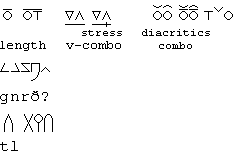
The standard alphabet, with ' and ,.

Diacritics, alternate symbols, other

Symbol: ![]()
The standard direction of writing is left to right, top to bottom, as in western scripts.
![]()
Symbol: ![]()
![]()
![]()
![]() Another much used direction is top to bottom, left to right.
Usually, this is accomplished by rotating both the line and the
letters 90 degrees to the right. Sometimes the tails of the
letters point downwards instead of upwards: this is known as the
icicle style. An alternate method is to only rotate the line, but
this is rare in handwriting.
Another much used direction is top to bottom, left to right.
Usually, this is accomplished by rotating both the line and the
letters 90 degrees to the right. Sometimes the tails of the
letters point downwards instead of upwards: this is known as the
icicle style. An alternate method is to only rotate the line, but
this is rare in handwriting.
These days, this direction of writing is mostly used for poems, quotations, in ads and for other short texts.
Symbol: ![]()
 or or |
 |
This is the rarest direction of writing. It is solely used on very formal occasions:
There must be an odd number of lines in a fan, and no more than nine lines is allowed, three is the most common. |
![]()
![]()
![]()
 If a fanned
text has more than one section, like a poem having more than one
verse, each section of text gets its own fan, and the fans are
stocked either in a line, or in pyramid-like structures. One
reads a pyramid by reading each row of fans left to right, from
the top fan to the bottom right fan. There can at most be five
per line and seven per pyramid.
If a fanned
text has more than one section, like a poem having more than one
verse, each section of text gets its own fan, and the fans are
stocked either in a line, or in pyramid-like structures. One
reads a pyramid by reading each row of fans left to right, from
the top fan to the bottom right fan. There can at most be five
per line and seven per pyramid.
[ TOP ]